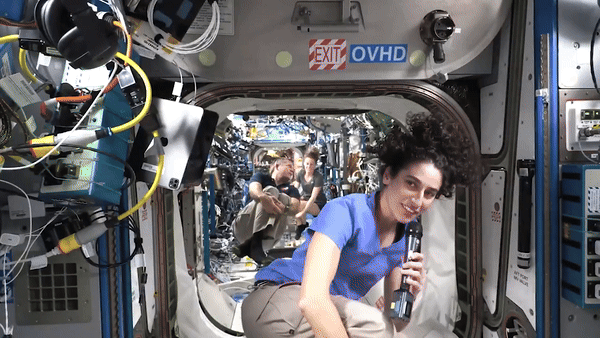
Move over, Space Mountain. Three astronauts created their own "amusement park" ride using an entire space station.
The International Space Station needs to raise its orbit, or reboost, every so often to avoid falling back into Earth's atmosphere. So a Russian Progress spacecraft fired its engines for 13 minutes on Jan. 27, putting the orbiting complex "a few miles higher" above our planet, NASA officials wrote in a blog post Jan. 29.
With this flurry of activity all happening on a Saturday, the Expedition 70 astronauts likely had a lighter work schedule as they orbited roughly 250 miles (400 km) above Earth. So they set up a video camera for X (formerly Twitter) crunched their bodies into little balls, and waited for the big moment to enjoy what would happen next.
Related: Watch next-generation lightweight spacesuit tested on Zero-G flight (photos, video)

With the camera running in the Harmony node, the three astronauts posed mid-air in microgravity with hands clasped gently above their knees. NASA's Jasmin Moghbeli gave running commentary on a microphone. Just behind, the European Space Agency's Andreas Mogensen posed near the doorway into the Destiny laboratory, with NASA astronaut Loral O'Hara floating further back in the U.S. science hub.
"It should be in about 10 seconds or so," Moghbeli said on video. A quick jump cut later, astronauts still in position, she noted, "We're still waiting."
Then the engines turned on and created a gentle force on the ISS. "There we go," Moghbeli called, beginning to fall backwards towards the doorway as reaction and counterreaction played out. Far in behind, Mogensen and O'Hara also began to fly back, slow-motion style.
Perhaps the cutest part of the video is watching the three astronauts, flying in balls like at a sports event, temporarily blocking the path of a confused-looking crew member far in the distance, trying to enter Destiny at the rear side.
Progress isn't the only kind of spacecraft that can make the ISS go higher. A commercial vehicle from Northrop Grumman, Cygnus, has also been tested for space station adjustments.
NASA and Russia always prefer to have several kinds of vehicles available in case one encounters issues, which came in handy for a few months after a Soyuz spacecraft for three astronauts sprung a coolant leak in December 2022.
While Russia was able to rush up a replacement Soyuz within a few months, in the meantime the agencies temporarily reassigned NASA astronaut Frank Rubio to SpaceX Crew Dragon in case of ISS evacuation. The other two crew members, Russian cosmonauts Sergey Prokopyev and Dmitry Petelin, were authorized to ride in Soyuz as the conditions inside were safe enough for fewer crew.







